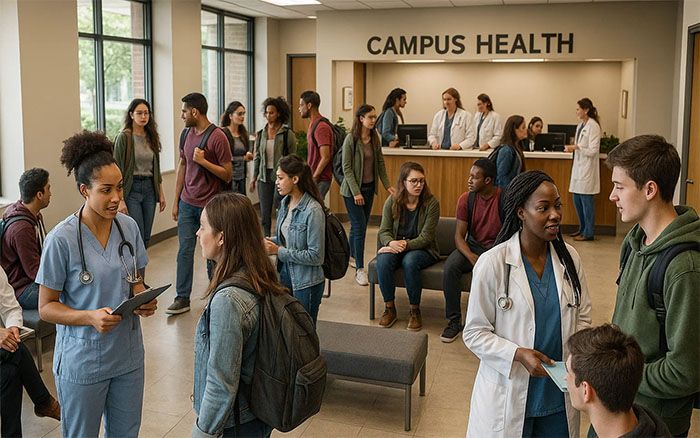Understanding the 2024 CCMH Report
Key Findings and Their Impact on College Mental Health
The 2024 Annual Report from the Center for Collegiate Mental Health (CCMH) provides an in-depth look at the mental health landscape of college students across the United States. This year’s findings emphasize the increasing complexity of student mental health concerns, particularly among those with a history of suicidal or self-injurious behaviors (S/SIB). The data highlights the essential role of college counseling centers in providing effective, yet often resource-limited, support for at-risk students.
In this blog, we explore five key insights from the 2024 CCMH Report. Keep reading to discover the latest trends that are most important for you to understand.
1. Students with a History of Suicidal or Self-Injurious Behaviors Require More Intensive Care
CCMH examined the experiences of students with a history of suicidal or self-injurious behaviors (S/SIB) and found that these individuals enter counseling services with higher levels of distress and co-occurring mental health concerns compared to their peers. These students:
- Utilize more specialized care, including psychiatric treatment and case management.
- Experience more critical events, such as self-harm or suicide attempts, during treatment.
- Show significant improvement through counseling services, but often continue to experience elevated levels of distress and suicidal ideation at the end of treatment.
This finding reinforces the importance of suicide prevention efforts within higher education and highlights the crucial role that counseling centers play in mitigating suicide risk. However, it also raises concerns about whether current short-term treatment models are sufficient for these high-risk students.
2. Increasing Demand for Mental Health Services
The report indicates a steady increase in students seeking counseling and utilizing psychotropic medications. Notably:
- Over 63% of students entering counseling services reported prior therapy experience.
- Rates of psychiatric hospitalization have slightly increased since 2020.
- History of trauma, while slightly declining in the past year, has increased significantly over the past 12 years, rising from 37.5% in 2012 to 45.5% in 2024.
These trends suggest that students are more willing to seek help and access mental health resources than in previous years. Colleges must prepare to meet this growing demand by expanding mental health resources, investing in staffing and trauma-focused training, and integrating support services across campus departments.
3. Anxiety and Relationship Issues Remain Leading Concerns
While anxiety remains the most common presenting concern for students, affecting 64.4% of those seeking services, the report also notes a growing trend in relationship-related issues.
Since 2020, students have increasingly sought support for relationship problems. Meanwhile, trauma-related concerns, which had been steadily increasing since 2016, saw a slight decline over the past year.
This shift emphasizes the need for counseling centers to adapt their services to address both longstanding and emerging student concerns. Integrating relationship-focused counseling with trauma-informed care allows institutions to provide more comprehensive and holistic support.
4. Threat-to-Self Trends: Stability with Some Areas of Concern
While some indicators of suicide risk have remained stable, others show an upward trajectory:
- The history of suicide attempts has increased from 8.7% in 2012 to 10.9% in 2024.
- Non-suicidal self-injury rates have slightly increased, whereas serious suicidal ideation has slightly declined.
The data suggests that while overall rates of suicide risk factors may not be dramatically increasing, there is a consistent presence of students who require intensive, ongoing mental health support. Addressing these concerns requires a multifaceted approach, including prevention programs, early intervention strategies, and crisis management services.
5. The Shift Back to In-Person Counseling
The mode of counseling service delivery has undergone significant changes since the onset of the COVID-19 pandemic. In 2020, nearly all students (96.1%) received counseling via video sessions. However, as of 2024:
- 7% of students now receive exclusive in-person counseling.
- Only 13.5% continue to receive care solely through video.
- Approximately 25% of students receive hybrid care (a mix of in-person and virtual sessions).
This shift indicates a strong preference for in-person support, reaffirming the importance of maintaining accessible, on-campus counseling services. While telehealth remains a valuable option, institutions should prioritize face-to-face interactions where possible.
How Colleges Can Support Student Mental Health Moving Forward
Given the increasing complexity of student mental health needs, institutions must take proactive steps to bolster their counseling services. The CCMH report outlines several strategies for enhancing mental health support on campus:
- Expand Specialized Care: Increased investment in case management, psychiatric care, and crisis intervention can better support students with severe mental health challenges.
- Promote Campus-Wide Collaboration: Connecting counseling centers with other campus resources, such as Title IX offices, financial aid, and disability services, ensures a holistic support system for students.
Have you explored the Okanagan Charter? Discover how it can strengthen cross-campus collaboration and enhance holistic student wellness.
- Invest in Suicide Prevention Programs: Expanding training for faculty, staff, and peers in recognizing and responding to signs of distress can help create a safety net for at-risk students.
- Enhance Access to Care: Given the growing demand, institutions should explore ways to reduce wait times, increase staffing, and implement innovative care models such as stepped care or peer support programs.
Key Takeaways
The 2024 CCMH Report reinforces the essential role that college counseling centers play in addressing the mental health crisis among students.
While counseling services are proving effective in reducing distress and suicidal ideation, persistent challenges—such as limited resources and increasing demand—necessitate ongoing institutional support. By investing in comprehensive, collaborative, and specialized mental health care, colleges can better support student well-being and academic success.
















